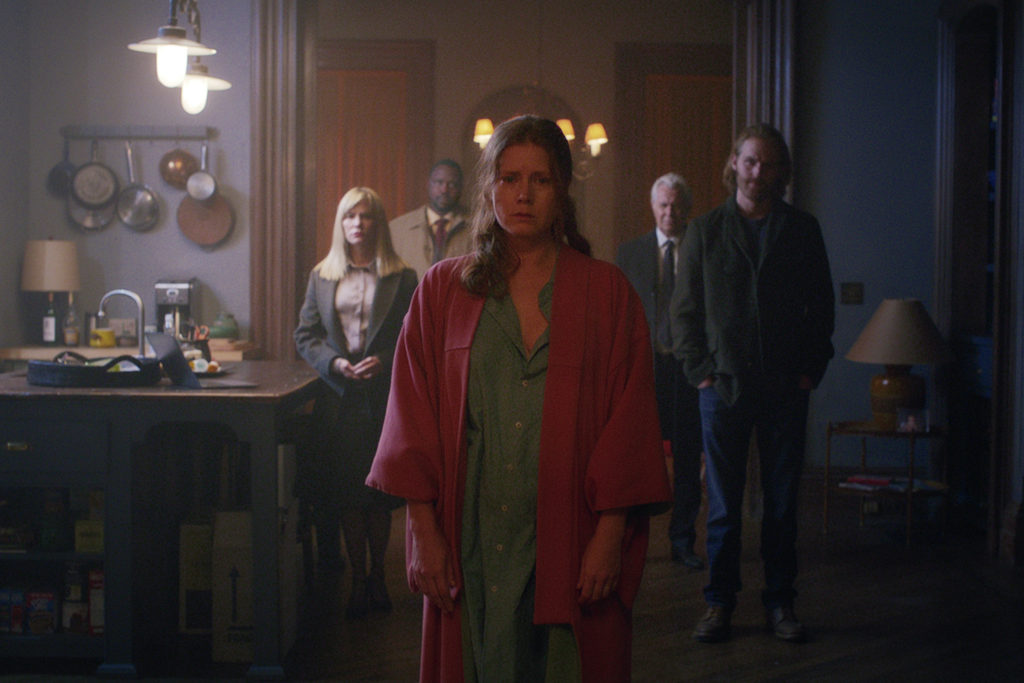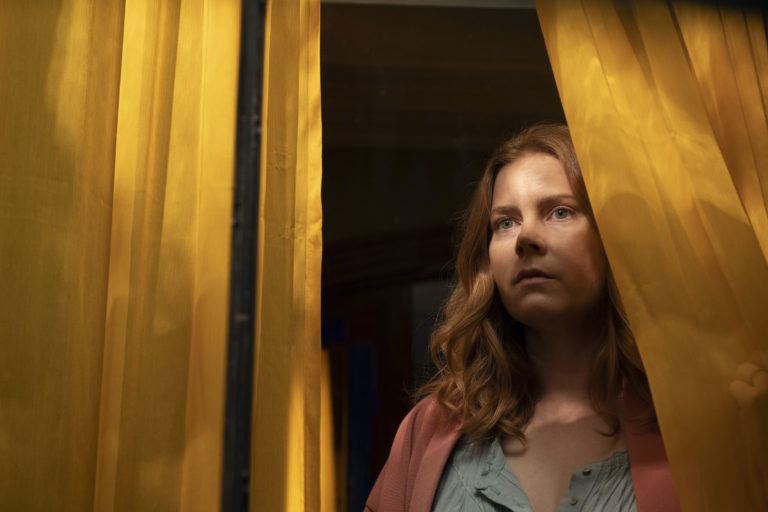The Woman in the Window (2021 | USA | 100 minutes | Joe Wright)
A.J. Finn’s The Woman in the Window was a literary hit in 2018, one of those page-turners in the mold of the Girl on the Train and Gone Girl with unreliable narration and suspenseful twists (with an pseudonymous author with a “trail of deceptions” of his own). I never read it, but got the sense that a decent share of its sales were hate-readers who couldn’t resist it mysteries yet threw their copies of the book at the wall in frustration when certain plot points were revealed. After a long time in pandemic purgatory, Joe Wright’s film adaptation finally drops this weekend on Netflix. The main selling point is that you can find out what the love/hate for the novel was all about in the span of less than two hours instead of burning through 448 pages.
Amy Adams continues her recent unfortunate streak of book-to-screen Netflix adaptations in the role of Doctor Anna Fox (the titular Woman), an agoraphobic psychologist unable to leave the sprawling brownstone in West Harlem that she shares with a fluffy white cat, a basement renter (an itinerant renter played by Bad Captain America Wyatt Russel), a film library of classic old movies, and a whole lot of bottles of wine. Fox spends her many spare hours by the titular Window, lightly spying on the daily happenings of her various neighbors for entertainment. She sprinkles in updates from their lives in her frequent phone calls with her husband (Anthony Mackie, in a largely vocal performance) from whom she is separated and in sessions with her visiting therapist (Tracy Letts, who also wrote the screenplay) who’s managing her increasingly complex psychopharmaceutical regimes and warning her about all those bottles of booze.
The humdrum monotony of observing prayer groups and orchestra practices is upended when a new family moves in across the street. Any new activity is compelling to a shut-in, so Anna quickly becomes fascinated by the newbies. Their weird teenage son (Fred Hechinger, giving a very moony performance) shows up one night to give her a gift (weird) and later, when some neighborhood kids attack her front door because she didn’t leave sufficient Halloween candy (OK, sure) a blonde Julianne Moore rescues her from the ensuing panic attack. Through all of Hans Zimmer’s intense strings, I may have missed the details of why NYC children are so ravenous for candy that they have to assault those who don’t meet their demands, but alas, there’s plot to feed. Anyway, the two of them spend the rest of the evening building an oddly-friendly rapport, making unfounded assumptions, and sipping their way through some giant glasses of red wine (as we learned earlier, maybe less booze with all the meds would be advisable).
So, you can imagine that when Anna gets back to peeping she’s quite upset to see her new buddy being straight up knifecrime murdered across the street. (Despite using a gigantic digital camera to do her snooping, she doesn’t take photos, which seems like a waste of technology). In case you don’t get the references, Joe Wright includes scenes of her watching Rear Window and at one point splashes bloody graphics across the screen. She calls the police, forces herself to leave the house to help, and immediately passes out (again). Things get considerably more weird when the police show up and she’s revived among a crowd of people who treat her like a crazy person.

New neighbor dad is played by Gary Oldman with bleached white hair and emotional affect turned all the way up to eleven. Brian Tyree Henry is the lead detective and the only one in the film who acts even remotely like a normal human (particularly in comparison to his partner, a cruelly robotic Jeanine Serralles). Things get even spookier when the woman she claims to have seen murdered shows up not only alive, but also looking like Jennifer Jason Leigh, also with Slytherin-white hair. Maybe this mystery played out as more mysterious or compelling in book form, but onscreen it comes across as instantly flimsy.
The film has a stacked cast and all of them seem to have tried to spend as little time on screen as possible, leaving it to Amy Adams to carry the whole thing. We’ve seen her before in heightened mystery-solving mode (e.g. Sharp Objects), but there’s only so much that a good actor can do when burdened with less than stellar material. She gives it her most as her Dr. Fox swans around her house’s many rooms and dramatic staircases in shapeless garments under the influence of pills and alcohol, obsessively trying to figure out what happened that night, doing internet sleuthing and more spying, and growing increasingly concerned for the welfare of her fifteen-year-old neighbor kid. As she struggles to be believed (or to question her own sanity) the story goes pretty predictably off the rails, and that’s even before the lights dim and the rug of a major plot twist is pulled out from under us in excessively dramatic flashback. From there, the mess gets even hotter, eventually devolving into a finale mired in conventional thriller tropes and incredibly annoying reveals.
It’s easy to be drawn into these psychological thrillers, but mysteries founded on unreliable narration and characters obfuscating even the most basic information often feel like they exist to purely to service the plot at the expense of their audience. As such, we’re left with Wright’s melodramatic direction (the man loves a staircase shot) set to an aggressively intense soundtrack while we wait for the next shocking development. I suppose there’s some amusement in the degree to which these story elements are heightened to evoke an emotional response, but my guess is that such pleasures are unintended consequences. With apologies to my local booksellers, knowing the twists leaves me unenthusiastic about investigating whether the flaws are inherent in the source material or are a victim of adaptation choices. At minimum, I learned what all the fuss was about in a format that was at least more captivating than a dry Wikipedia synopsis.
The Woman in the Window is now streaming on Netflix.



